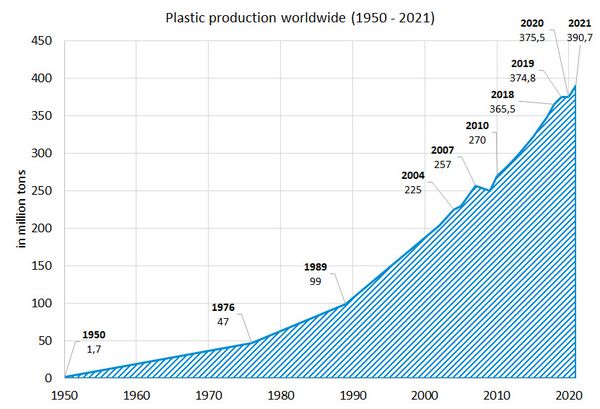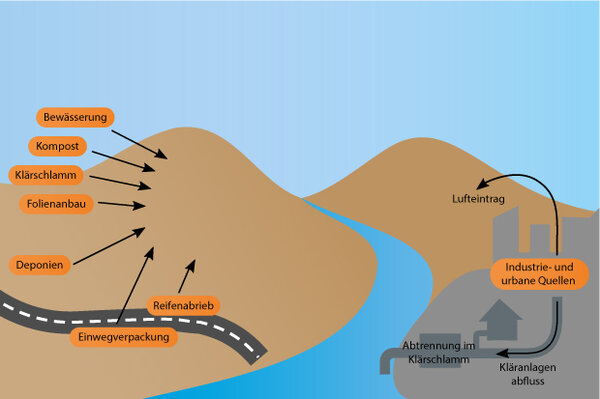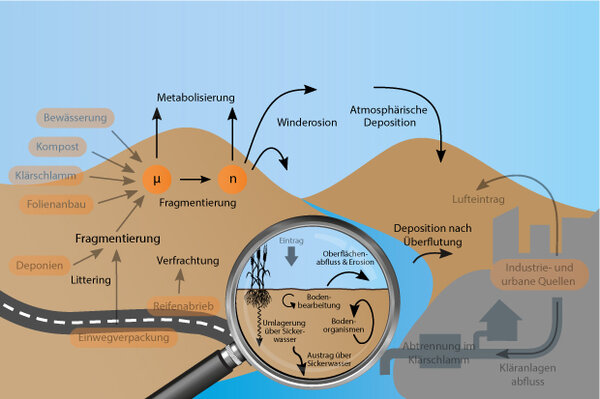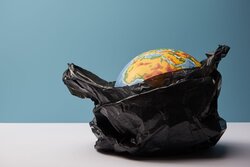Dossier
Plastic in soil
Daniela Thomas, Elke Brandes | 20.04.2023
To what extent is plastic in soil? And how does it act there? Because little research has been done on the topic in the past, these questions remain largely unanswered.
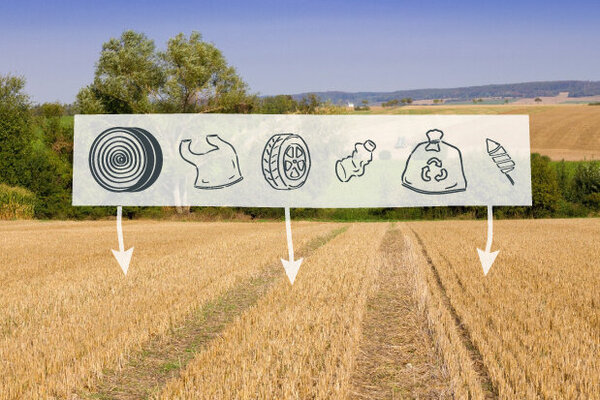
The pollution of the world's oceans with microplastics has increasingly come into public focus in recent years. This has led to the first scientific findings on the origin, input, fate, and effect of microplastics in marine ecosystems. Far less is known about the contamination of terrestrial ecosystems with plastics, although plastic contamination is estimated to be higher on land than in the oceans.
In particular, microplastics can be carried into surface waters from agricultural soils through erosion. Similarly, microplastics accumulate in agricultural soils.
To develop prevention strategies for the input of microplastics into agricultural soils and water bodies, the extent of contamination, the fate and effects in the soil, and the potential for discharge into water bodies must first be researched. Efficient solutions can only be developed once the main sources are identified.
Plastic production since 1950
With an initial global production of about 2 million tons per year, plastic has been produced primarily by industry since the 1950s. The term plastic covers a whole range of synthetic polymers that differ in their composition and thus in their chemical-physical behavior. Thanks to the wide range of possible applications, the low production costs, and the durability of these materials, plastic has become an indispensable part of our everyday lives.
Plastic is used in all areas of life, in part directly in our environment. It is also used in agriculture, for example as mulch film in the field, during ensiling, or in the form of nets for wrapping straw bales. In Europe, approximately 57.2 million tons of plastic were produced in 2021, 3.1 percent of which was for the agricultural sector (Plastics Europe 2022).
After use, most of the plastic is disposed of. In 2010, 14.5 million tons of plastic waste were produced in Germany.
Definition of microplastics
A generally accepted definition for microplastics does not yet exist. It is currently being developed by the International Standards Committee ISO/TC 61 "Plastics Currently, plastics are often classified into macro- (>25 mm), meso- (5-25 mm), and microplastics (large microplastic: 1-5 mm and microplastic: 1-1000 μm). Even smaller plastic particles are referred to as "colloidal plastic" (100-1000 nm) and "nanoplastic" (below 100 nm).
Microplastics are further divided into primary and secondary microplastics. Primary microplastics are plastics that are introduced into the environment in the form of tiny particles. Secondary microplastics are created from larger pieces of plastic by mechanical action or fragmentation, e.g. by solar radiation in the environment.
Plastic input into soils
The suspected pathways of plastic input to soils are diverse. For example, to increase yields, plastic can be introduced into soils through mulch films and plastic covers used in vegetable, fruit, and asparagus production. Other input pathways in agriculture represent fertilization with sewage sludge or compost. For example, microplastics from cosmetics, detergents, and fiber abrasion from washing synthetic textiles are introduced into wastewater. When treated in wastewater treatment plants, over 95% of these particles end up in sewage sludge. Some of it is used in Germany in agriculture, but also in the recultivation of open-cast mining areas.
Important but little-studied input pathways outside the agricultural sector include tire abrasion from motor vehicles, plastic from the air (atmospheric deposition), and improper disposal of plastic products (littering). It is estimated that in Germany about 0.3% of plastic waste enters the environment through littering (BKV study).
Data on (micro-)plastics in soil are so far very patchy, so little is known about the relevance of the different sources.
When plastic remains in soils
Little is currently known about the fate of plastic in soil. In the environment, the advantage of stability and longevity of the plastic material, achieved by added additives (e.g. UV stabilizers), becomes a disadvantage. This is mainly because degradation via natural processes, e.g. by microorganisms in the environment, takes place only very slowly or not at all.
An important process is the fragmentation of plastic into smaller and smaller particles. This can be enhanced by solar radiation, mechanical processing, and uptake and excretion by soil organisms. For example, film residues from agriculture that are inadvertently left in the soil can be crushed and distributed in the plow horizon by mechanical tillage and solar radiation. In addition, microplastics are thought to be transported vertically and horizontally by earthworm activity in the soil.
Researchers assume that microplastics can enter groundwater via the soil. Thus, rearrangement in the soil or discharge from the soil is probably also significant. Due to the lower density of the most common types of plastic compared to soil particles, wind, and water erosion play a particularly important role.
Impact of plastics and microplastics
When assessing the harmful potential of (micro)plastics, their great heterogeneity must be taken into account. A basic distinction is made between harmful effects triggered by the plastic substance itself and by added additives (e.g. plasticizers) as well as by the absorption of pollutants (e.g. pesticides). Another aspect is the aesthetic and socio-economic impacts of visible plastic pollution, especially in natural and semi-natural landscapes.
Few scientific studies have shown that microplastics, like other natural soil particles, are ingested and excreted by soil organisms (e.g., earthworms) (Boots et al 2019). Similarly, minute plastic particles can be ingested by plants.
It is believed that as the size of the particles decreases, their potential to cause harm increases (Büks et al 2020). Much of the toxicological studies to date have been conducted in model experiments in the laboratory - using very high concentrations of microplastics that have not previously been measured in the environment. Thus, the harmful effects of microplastics on soil cannot yet be definitively assessed at the current state of knowledge.
Read more:
Daniela Thomas, Melanie Braun, Kristof Dorau, Peter Fiener, Martin Hoppe, Sarmite Kernchen, Christian Laforsch, Martin Löder, Natalie Orlowski, Zacharias Steinmetz; Plastik in Böden: Fortschritte und Herausforderungen; Bodenschutz 2.25, 30. Jahrgang, Bundesverband Boden e.V. (in German)

